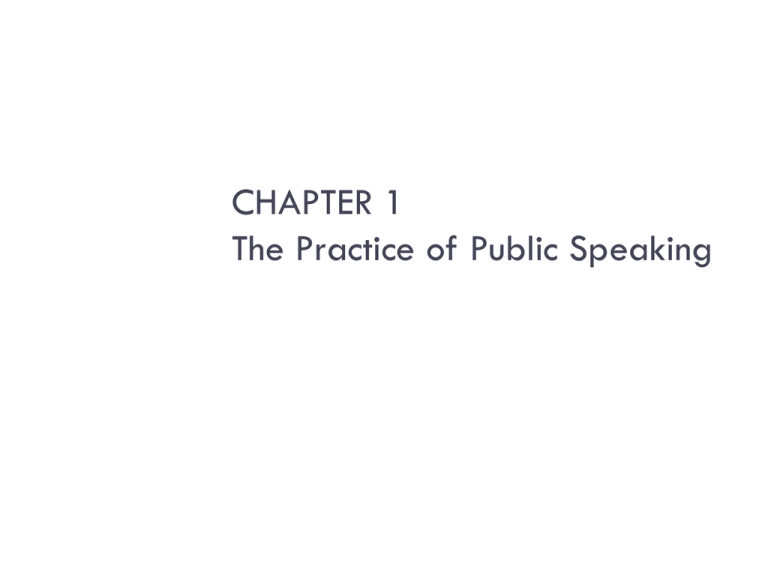CHAPTER 1 The Practice of Public Speaking
advertisement

CHAPTER 1 The Practice of Public Speaking Educational Benefits Oral presentations are common classroom assignments across the disciplines. Organization skills are applicable to most other courses. Critical thinking skills are used in most assignments across the disciplines. Listening skills are important for all classes. Research indicates a correlation between GPA and communication competence (Rubin, 1988). When getting to know people in a social setting, research states that communication competence affects physical attractiveness (Duran & Kelly, 1988). Professional Benefits Success in a job interview depends on your ability to “sell” your abilities with a clear, organized, and articulate manner (Floyd, 2014). Employers seek communication skills, team work skills, and interpersonal abilities. It’s the number one skills sought. (Hansen & Hansen, 2007; Young, 2003; Koncz, 2008; NACE, 2010) In Engineering, speaking skills were important to 72% of employers surveyed (Darling & Dannels, 2003) A survey of more than 400 employers identified “communication skills” as the top skills employers seek in job applicants and is rated above technical competence, work experience, or academic background (Job Outlook 2004, National Association of Colleges and Employers). In a survey of 500 U.S. businesses, more than 90% of personnel officials state that communication skills are needed for success in the 21st century (Peterson, 1997). Personal Benefits: Good communication skills can lead to greater confidence and satisfaction in life Good communication skills can enable you to express your values and explore the values of others Good communication skills can sharpen your ability to reason and think critically Good communication skills can improve relationships. Good communication skills can affect you present yourself in social settings. Effective communication is a major contributor of marital satisfaction (Kirchler, 1988). Why Study Communication? cont. Physical needs Fredrick II, emperor of Germany from 1196 to 1250 illustrated the importance of communication (Ross and McLaughlin) Five people are isolated and remain alone in a locked room (Schachter, 1959) John McCain talked about 6 years of solitary confinement (McCain) Russian Experiment to Mars? Locked away for 520 days? http://news.bbc.co.uk/2/hi/europe/7966731.stm http://www.cbc.ca/technology/story/2010/06/02/russia-mars-experiment-travel.html?ref=rss http://news.bbc.co.uk/2/hi/europe/8150385.stm Why Study Communication? cont. Physical needs People who lack strong relationships have 2-3 times the risk of early death. (Duck, 1992) Divorced, separated, widowed people are 510 times more likely to be hospitalized for mental illness (Duck, 1992) Social isolation similar to cigarette smoking, obesity, lack of exercise, and diet?????? People who are socially isolated are 4 times more likely to get the common cold (Cohen, Doyle, Skoner, Rabin, Gwaltney, 1997) (as well as The Journal of the American Medical Association) Definition of Communication: What examples come to mind when you think of the term “communication”? Adler and Rodman’s definition of communication: “The process of creating meaning through symbolic interaction.” Verderber, Verderber, and Sellnow’s definition of communication: “The process of creating or sharing meaning in informal conversations, group interaction, or public speaking.” My definition of communication: “The process of creating and/or sharing intentional and/or unintentional meaning through nonverbal and verbal messages in informal conversation, group interaction, or public speaking.” In the community Being an Engaged Citizen Students from the Asian Student Association clean up trash from the local beach. Public issues require citizens to make decisions or take actions. Change occurs when people speak up and work together to solve societal problems. Community Service? Discuss your past experiences. Communication Settings/ Communication Contexts: Qualitative vs. Quantitative Intrapersonal communication Interpersonal communication (dyadic?) Small group communication Public communication Mass communication Comparing public speaking to other types of communication contexts SIMILARITIES You must speak to other people. You must think about your listeners and their needs. You must be understood when you speak. You must be responsible about what you say and how you speak. DIFFERENCES You have less opportunity for a response or feedback from your listeners. You are responsible for more of the message content. You must pay closer attention to nonverbal cues and use a formal voice. The Elements of the Communication process: Participants (Speakers / Source) Encoder Decoder Message messages are created (encoded and decoded) by symbols to which meaning is assigned. Context / Situation Physical context, social context, historical context, psychological context, cultural context Channel Interference (Noise) Physical noise, Psychological noise, Semantic noise Feedback The Communication Process (the transactional model of communication) Cultural Sensitivity Culture – language, beliefs, values, norms, behaviors, and objects that are shared by a group of people Speakers recognize the values, behaviors, and artifacts that are important to the cultural group to which they are speaking. A culturally sensitive speaker avoids making ethnocentric remarks and addresses cultural differences with respect.

